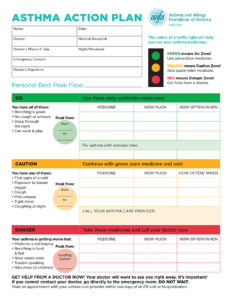When you have a child with asthma, there are certain accommodations you must make to manage it. One of the things that too many parents don’t have is an asthma action plan. This is imperative for people of any age, and as a parent of a child with asthma, you should have one in place for their care. What does that action plan include and how do you create it? Read on.
What Is an Asthma Action Plan?

Asthma action plan from AAFA
In short, an asthma action plan is written documentation of how to manage asthma at every stage. This includes medication, your child’s specific reaction to certain triggers, what to do when an attack occurs, and when it’s time to take your child to get medical attention. Thankfully, you don’t have to build this plan from scratch since several reputable organizations offer templates, including:
- Asthma and Allergy Foundation of America (AAFA)
- The Centers for Disease Control and Prevention (CDC)
- American Lung Association
Once you find a template that works best for your child, be sure to tailor it specifically for their needs.
Why You Need a Plan
When your child is with you, you probably know exactly what to do and how to manage any asthma attacks. However, your child will not always be with you. There’s school, camp, extracurricular activities, grandparents and other family members, daycare, and sitters. You can’t expect everyone to know exactly how to care for your child, especially in a setting that includes several children. Plus, for a school or other institution, they’ll probably require an asthma action plan so they know exactly what to do and when.
As your child gets older, the plan should be amended and shared with them. An asthma action plan is suggested for people of all ages, and as a child grows, it’s important to empower them to take control of their own healthcare needs.
The Components of the Plan
As you’ll see from the example here (and at any of the above links), most asthma action plans include green, yellow, and red categories. Just as with traffic lights, the colors indicate the actions to take as symptoms get progressively worse. Plus, kids can easily relate to such a color system.
Green indicates normal conditions. These are standard medications your child takes on a daily basis and what they need to do before, during, and after exercise, such as they might be involved in on the playground or in a gym class.
Yellow indicates that there are some issues with your child’s breathing or condition. They could be experiencing breathing challenges, wheezing, or coughing, often associated with a triggering activity. Again, medications to take immediately will be highlighted. The goal is to diminish symptoms and transition to the green zone within an hour. If, however, symptoms accelerate, your child could move into the red zone.
As with traffic lights, red indicates it is time to stop. Stop attempting to manage symptoms at home and call your pediatrician. When your normal doctor is unavailable, take your child to urgent care or the emergency room to be seen immediately. Be sure to include your doctor’s name, phone number, and address, as well as the name and address of the nearest (or preferred) hospital on your action plan.
Share Your Asthma Action Plan
Keep a copy of your child’s asthma action plan in your home and let everyone know where it’s located. You can make copies of that plan or create alternative plans for school, daycare, and any other place your child frequents (see AAFA for variations on the initial action plan).
For daycare, school, and camp, schedule an appointment with the nurse or director to review your child’s asthma action plan. Add your name and phone number, as well as that of your child’s other parent, any close family members, and of course, your pediatrician. These institutions may also require a medical card to be kept on file, in addition to your asthma action plan, which gives them permission to make decisions on your behalf if your child is in distress and you are not reachable.
Trust Community Choice Pediatrics with Your Asthmatic Child
At Community Choice Pediatrics, we are experts in supporting families with asthmatic children. We can help you create your asthma action plan and, of course, provide ongoing care of and treatment for your child’s symptoms. We are here for you to answer your questions and make your family ready to handle any issues that arise. Contact us to schedule your appointment.

